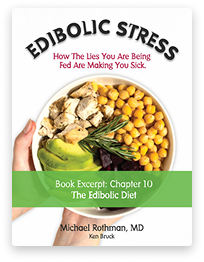Fibromyalgia
Addressing Fibromyalgia

If the underlying root causes of your fibromyalgia are left untreated, these insidious factors will eventually lead to damage to many of your body systems. Unfortunately, symptoms of fibromyalgia are often dismissed as a psychiatric illness or diagnosed and treated improperly.
At Michael Rothman MD, we adopt a functional and metabolic medicine approach to fibromyalgia, focusing on personalizing your care. By addressing root causes such as hormonal and metabolic imbalances, chronic inflammation, environmental toxicities, and stealth infections, our tailored treatment plans offer you long-term relief and improved health outcomes. Unlike conventional treatments that primarily manage your symptoms, our approach aims to restore your balance and vitality.
Ready to Take Control of Your Health?
If you are experiencing symptoms of Fibromyalgia and are seeking effective, metabolically directed treatments, contact us online or call (732) 268-7663 for a consultation.
What are the Symptoms of Fibromyalgia?
The symptoms of fibromyalgia can vary widely among individuals, but the most common include physical, cognitive, and emotional challenges that significantly impact your daily life. Those often include:
- Chronic Fatigue: Persistent and overwhelming tiredness that doesn’t improve with rest, often making even simple daily tasks feel insurmountable.
- Widespread Pain: A constant, dull ache that occurs on both sides of your body and above and below your waist, often described as deep muscular tenderness.
- Fibro Fog: Cognitive difficulties, including memory lapses, trouble concentrating, and a general sense of mental cloudiness that can disrupt your work and daily activities.
- Sleep Disturbances: Difficulty falling asleep, staying asleep, or waking up feeling unrefreshed, often exacerbating your fatigue and other symptoms.
- Heightened Sensitivity: Increased sensitivity to touch, light, noise, or temperature, often leading to discomfort in your everyday situations.
- Mood Disorders: Depression, anxiety, and mood swings, which may develop due to chronic pain and the condition’s impact on your quality of life.
- Headaches or Migraines: Frequent and sometimes debilitating headaches, often linked to muscle tension, inflammation or hormonal and metabolic imbalances.
- Irritable Bowel Syndrome (IBS): Digestive issues like bloating, abdominal pain, constipation, or diarrhea, which are commonly co-occurring with your fibromyalgia.
- Muscle Stiffness: Generalized stiffness, particularly upon waking or after periods of inactivity.
- Tingling or Numbness: Unusual sensations in your hands and feet, such as a pins-and-needles feeling, often without a clear cause.
If you are experiencing a multitude of these seemingly unrelated symptoms, it may indicate that you have an underlying inflammatory condition. Consulting a knowledgeable doctor is essential for an accurate diagnosis and effective treatment. A holistic, metabolically directed approach can help address the root causes of your symptoms, restore balance, and improve your overall well-being.

Our Functional and Metabolic Medicine Approach to Fibromyalgia
At Michael Rothman MD, we understand the significant impact that environmental exposures, stealth infections, hormonal and metabolic imbalances have on your pain levels and overall well-being. Our approach to treating fibromyalgia involves a comprehensive, metabolically directed method to identify and address the root causes of your symptoms.
Learn More About Our Metabolic
Approach To Fibromyalgia
Diagnostic Methods Used:
- Comprehensive blood tests to evaluate nutritional deficiencies, thyroid status, and hormone levels.
- Functional metabolic testing to assess your anabolic/catabolic balance, autonomic nervous system balance and acid-base balance.
- Advanced stool testing for identifying dysbiosis, stealth infections, and inflammatory markers.
- Organic Acid Testing (OAT) – to assess nutritional deficiencies, oxalate levels, mitochondrial function and neurotransmitter activity
- Genetic testing to detect predispositions, including susceptibility to environmental triggers.
- Mycotoxin and heavy metal assessments to uncover hidden environmental contributors.
Potential Treatment Options:
- Lifestyle modifications, including stress reduction techniques, sleep hygiene, and regular exercise.
- Personalized dietary plans focusing on anti-inflammatory foods and nutrient optimization.
- Bioidentical hormone replacement therapies to correct imbalances in adrenal, thyroid, and sex hormones.
- Metabolic therapies to normalize impaired homeostatic control systems.
- Detoxification protocols targeting heavy metals, mold exposure, and other environmental toxins.
- Supplementation with tailored vitamins, minerals, other nutraceuticals and probiotics to support your overall health.
Why Choose Functional and Metabolic Medicine for Treating Fibromyalgia?
Fibromyalgia is a challenging condition that traditional medical approaches often fail to fully address. Most conventional treatments focus on management of your symptoms with medications such as pain relievers, antidepressants, and muscle relaxers. These pharmaceutical drugs may provide short-term relief but often miss the underlying causes of your problems. This drug-based approach can leave you stuck in a cycle of chronic pain and fatigue without lasting solutions.

At Michael Rothman MD, we approach fibromyalgia differently. Our functional and metabolic medicine approach focuses on uncovering and addressing the root causes of your condition, such as hormonal imbalances, oxidative stress, and environmental toxins. Using advanced diagnostics, we evaluate factors like homeostatic dysregulation, stealth infections, dysbiosis, chronic inflammation, and metabolic dysfunction to create a personalized treatment plan. This tailored approach includes dietary modifications, natural therapies, and lifestyle adjustments designed to restore your balance and alleviate your symptoms at their source.
Choosing functional and metabolic medicine means choosing a deeper level of care. Our approach not only focuses on relieving your symptoms but also enhances your body’s natural healing processes, promotes long-term vitality, and empowers you to regain your quality of life. With personalized treatment that addresses your unique health challenges, we aim to deliver meaningful, lasting improvements.
Ready to Take Control of Your Health?
If you are experiencing symptoms of Fibromyalgia and are seeking effective, metabolically directed treatments, contact us online or call (732) 268-7663 for a consultation.
Meet Dr. Michael Rothman:
Holistic Health and Metabolic
Medicine Expert

Frequently Asked Questions
Fibromyalgia is a complex condition often caused by a combination of factors, including chronic inflammation, hormonal imbalances, metabolic dysfunction, stealth infections and environmental stressors. Frequently, issues such as adrenal or thyroid dysfunction, abnormal tissue pH, and oxidative stress contribute to development of fibromyalgia. Identifying and addressing these root causes is essential for effective management of your problems.



